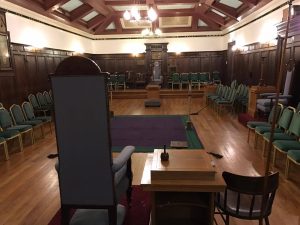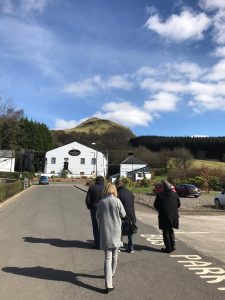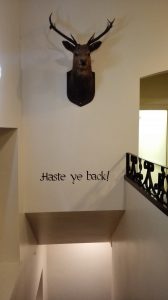Masonic Journey to Scotland

Day 1: Visit Edinburgh
We start wit a scenic Edinburgh visit, which includes: the old town and the new city The World Heritage of UNESCO, the Scottish Parliament and the Palace of Holyrood, residence of the Queen. The last stop will be Calton Hill, a hill overlooking the city of Edinburgh, from where you can admire the magnificent panoramic view from the city.
After the lunch you’ll visit one of the most famous attractions of the city, the Castle of Edinburgh where the jewels of the Scottish crown are preserved. It was the residence of many Kings and Queens, including Mary Queen of Scots and King James I of England, her son.
Visit of the old town and the Cathedral of St Gilles.
Day 2: Visit Melrose Abbey, Rosslyn Chapel and Celtic Lodge No. 291
Visit of the Abbey of Melrose: Impressive ruin, this Gothic abbey was founded in 1136 by Cistercian monks at the request of King David I of Scotland. Considered one of the most beautiful religious edifices in the kingdom, the abbey is remarkable for the astonishing preservation of its effigies. The architecture of this building is considered one of the most delicate of Scotland.
Visit of Abbotsford House. Abbotsford House is a historic residence, home of the British writer Walter Scott who was one of the most illustrious figures of British romanticism, known for his historical novels Ivanhoe and Quentin Durward and also, Waverley and Rob Roy. Walter Scott bought in 1811 the small farm of Cartley Hole which he completely transformed, renamed Abbotsford and where he lived the last twenty years of his life. The house was opened to the public in 1833 and was occupied by the descendants of Walter Scott until 2004. This house remains one of his great works, we think of Victor Hugo’s house in Guernsey, Hauteville House, which occupied and Passionated his owner for years, to make it an important creation, to our delight. Lunch at the Abbotsford House Restaurant.
On our way we stop at Scott’s View to enjoy the beautiful scenery. Visit Chapel of Rosslyn: It was designed by William Sinclair and was built in 1440 and finished forty years later, located south of Edinburgh and is usually associated with the Temple Order. Has many symbols belonging to these knights. This mythical connection inspired the American writer Dan Brown for his famous Da Vinci Code.
The day ends with a visit to Celtic Lodge No. 291.
Day 3: Visit Grand Lodge of Scotland, Lodge Mary’s Chapel and Glenkinchie Distillery
Visit of the Grand Lodge of Scotland. The Great Temple, the offices of the Grand Master, visit of the Museum and the rooms of the commission. Then you will go to Mary’s Chapel on foot. In the afternoon you’ll  visit the Glenkinchie distillery, which is today One of the last three in the “Terres Basses”, south of Edinburgh. The production of the famous “water of life” in Scotland begun around 1825. Glenkinchie whiskey is a typical whiskey of the “Terres Basses”, fresh, light in character, and with lemony notes. The perfect whiskey for novices. After the visit of the distillery, you will of course be able to taste a “drachma” of this precious beverage.
visit the Glenkinchie distillery, which is today One of the last three in the “Terres Basses”, south of Edinburgh. The production of the famous “water of life” in Scotland begun around 1825. Glenkinchie whiskey is a typical whiskey of the “Terres Basses”, fresh, light in character, and with lemony notes. The perfect whiskey for novices. After the visit of the distillery, you will of course be able to taste a “drachma” of this precious beverage.
Day 4: The Highlands
The route will take you to your first visit to the Doune Castle. This castle appeared in a part of the filming of the film Monty Python and the Holy Grail. Then you will pass by the Trossachs National Park and Loch Lomond. Loch Lomond is the largest body of water in the United Kingdom. A popular holiday destination for Glasgow residents, this Loch offers a relaxing, contemplative space on the Highlands’ boundary line, where you can see that the surrounding landscape evolves quickly along the loch. For fans of Tintin, Loch Lomond must surely remind you of something: it’s the name of Captain Haddock’s favorite whiskey. After lunch you’ll continue to Luss.
The most picturesque village of Loch Lomond and a small, quiet and relaxing little mining village at the foot of the Highlands. Its coquettish streets and parishes offer strolls and magnificent views along the banks of the Loch. You will then take the road to Inveraray. A delightful whitewashed town, this village has a superb waterfront facing the upstream part of Loch. You’ll visit Inveraray Castle. Since the beginning of the 15th century, it has been the stronghold of the Clan Campbell. The castle we see today was built at the end of the 18th century by Roger Morris and Robert Mylne. You will see the large hall and the armory, the state rooms, the tapestries, the tables and the furniture of the 18th century and an old kitchen. Those interested in the genealogy and history of the Campbells will find the visit of the Campbell Room particularly interesting.
You’ll continue to Kilchurn Castle and continuation to ST Conan Kirk which will be very appreciated by the Brothers. The tour will end this day in Oban.
Day 5: Glencoe and Skye
You will leave this morning to other places to take your breath away. You’ll stop at Glencoe, the most famous of the Scottish valleys. Because of its size, power and variety of landscapes, Glencoe offers a grandiose setting of discovery and emotion. The rocks that surround you, go back, for the oldest, to 400 million years and for the youngest to almost 100 million years. You will stop in front of the three dominant peaks, a typical landscape that belongs only to Glencoe, the Three sisters of Glencoe (the three sisters). Your guide will of course tell you about the tragic history of the “Glencoe Massacre”.
You will then pass by Fort William nestled at the foot of Ben Nevis, the highest mountain in the United Kingdom. Then follow the beautiful Route des Îles between Fort William and Mallaig. On the way you’ll stop at the Glenfinnan Monument erected in 1815 in honor of the soldiers who died for the Jacobite cause. After the lunch in Mallaig you’ll check in for the ferry to Skye.
stop at the Glenfinnan Monument erected in 1815 in honor of the soldiers who died for the Jacobite cause. After the lunch in Mallaig you’ll check in for the ferry to Skye.
After the short ferry crossing, you will arrive at Armadale, in the south of the island. Departure to Sligachan. There are places on Earth that Mother Nature has particularly spoiled: the island of Skye is one of them! The island is renowned for its landscapes, often considered the most beautiful in Britain. But we can not imagine how spectacular the views of the island are, as are the majestic Cuillin mountains, Skye is a permanent sight … You will arrive at the village of Sligachan where you will have a beautiful imposing hillside views of Cuillin Hills.
Day 6: Eilean Donan, Loch Ness and Inverness
After departure to Kyle of Lochalsh you will cross the bridge that connects the island of Skye to the mainland Scotland. Photo stop at the Castle of Eilean Donan where a large part of the film Highlander was shot. Next stop will be the famous Loch Ness. It is an amazing 38.5 km long lake located in the Great Glen part of the Caledonian Canal that connects Fort William with Inverness. It is 213 m deep and contains the largest volume of fresh water in the islands of Great Britain. He is known all over the world for his mysterious inhabitant of the Loch Ness Monster, Nessie. Here you will visit the Urquhart Castle.
After the visit you will have a cruise on Loch Ness to Clansman Harbor. After the cruise and the lunch you will have a little city tour through Inverness. Capital of the Highlands, Inverness is one of the most dynamic British cities. A large city and trade center of the Highlands, Inverness occupies an enchanting site at the mouth of the Ness at the northern end of the Great Glen.
Day 7: Back to Edinburgh
This morning you will leave the Highlands to cross Scotland, enjoying the extraordinary scenery as you make your way to back to Edinburgh. Crossing the Cairngorms National Park, you will continue to the south of Scotland. After arrival in Edinburgh and hotel you’ll have the afternoon to discover the city.
Day 8: Last day, Holyrood Palace
The last day you’ll visit Holyrood Palace. Palace of Holyroodhouse is the official residence of the United Kingdom monarch in Scotland. King David I of Scotland founded a monastery in 1128, but since the 15th century it served as the main residence of the kings and queens of Scotland. The palace is at the foot of the Royal Mile in Edinburgh, at the other end of Edinburgh Castle. Queen Elizabeth II stays there one week at the beginning of each summer, to hold garden parties and official ceremonies. From there she goes to Balmoral Castle (belongs to her) for her two-month summer holiday. Holyrood is an angel of the Scottish Haly Ruid, which means Holy Cross. The street Abbey Strand runs to the building.

This tour includes:
– Guide
– Accommodation
– Transport
– Visits
Not included:
– Lunches
– Dinner on days 3 and 8
– The drinks
– A bus for the afternoon of day 2 and the evening
– The drinks
– Personal expenses
– The insurance
– Guide Francophone
